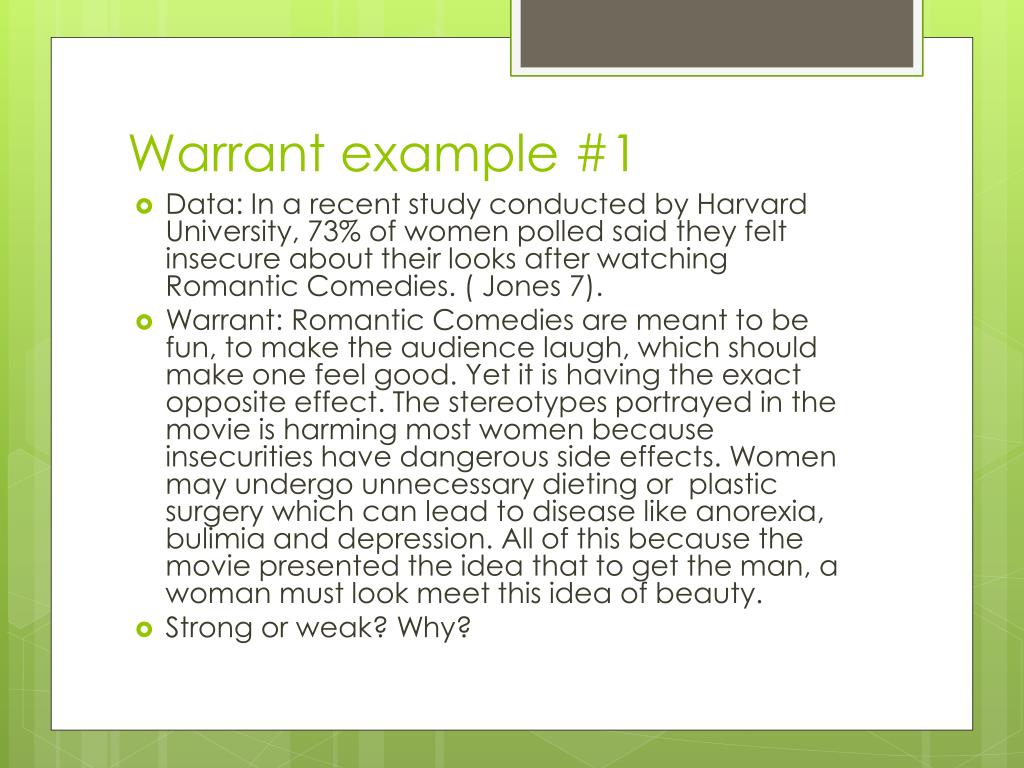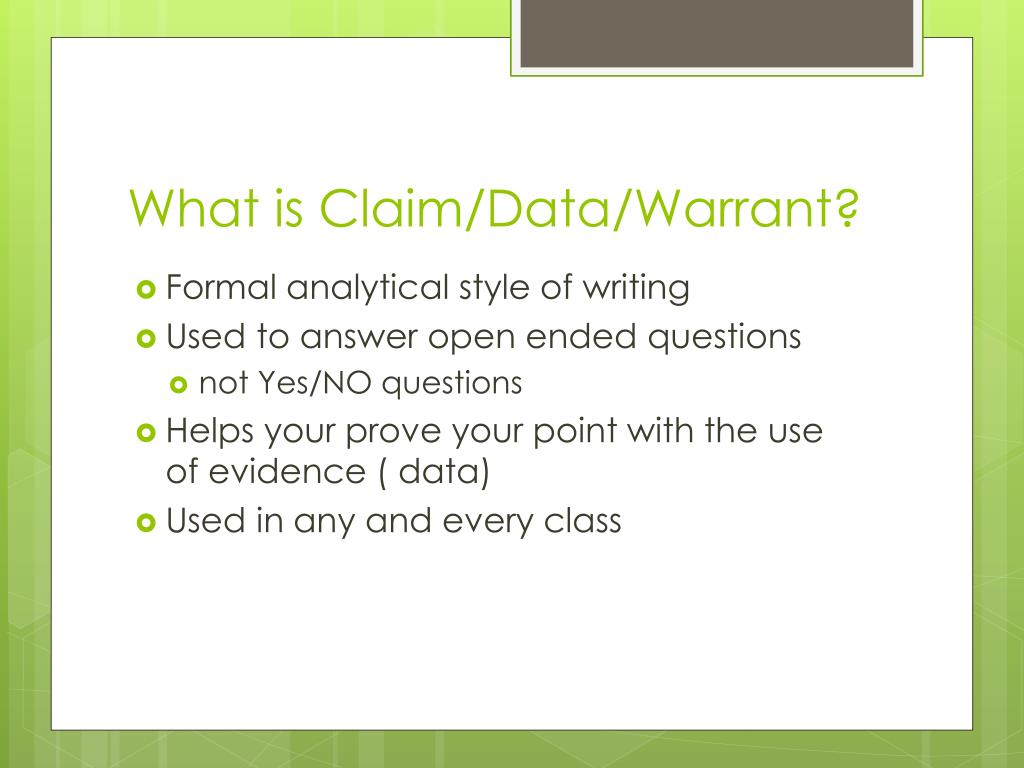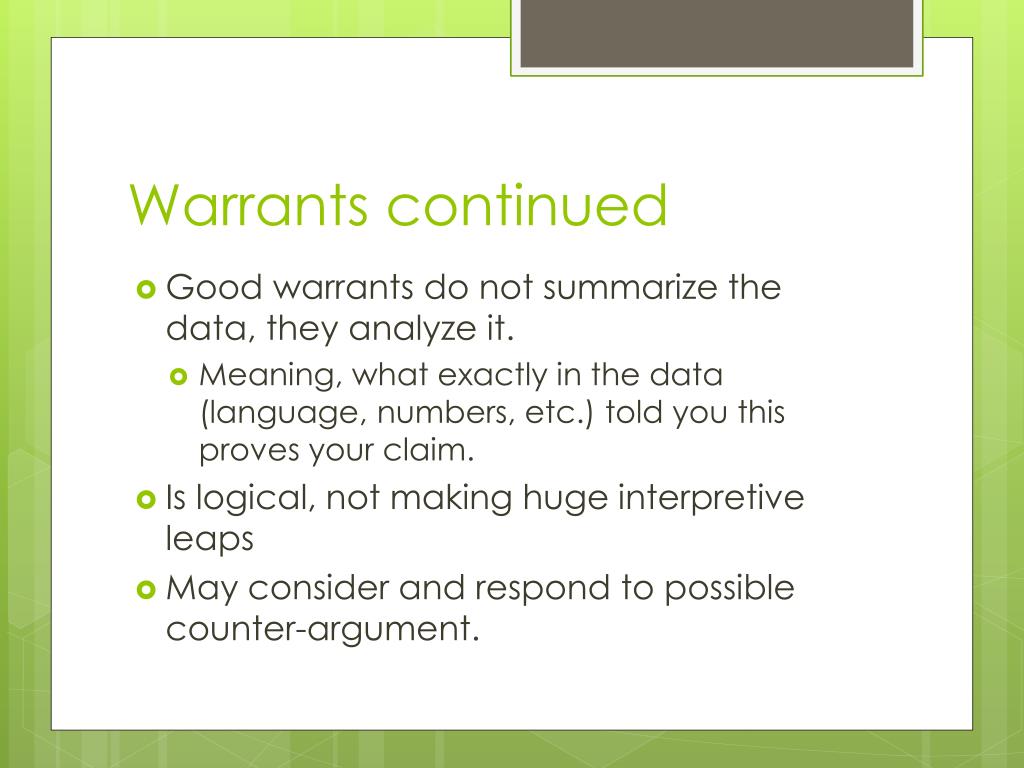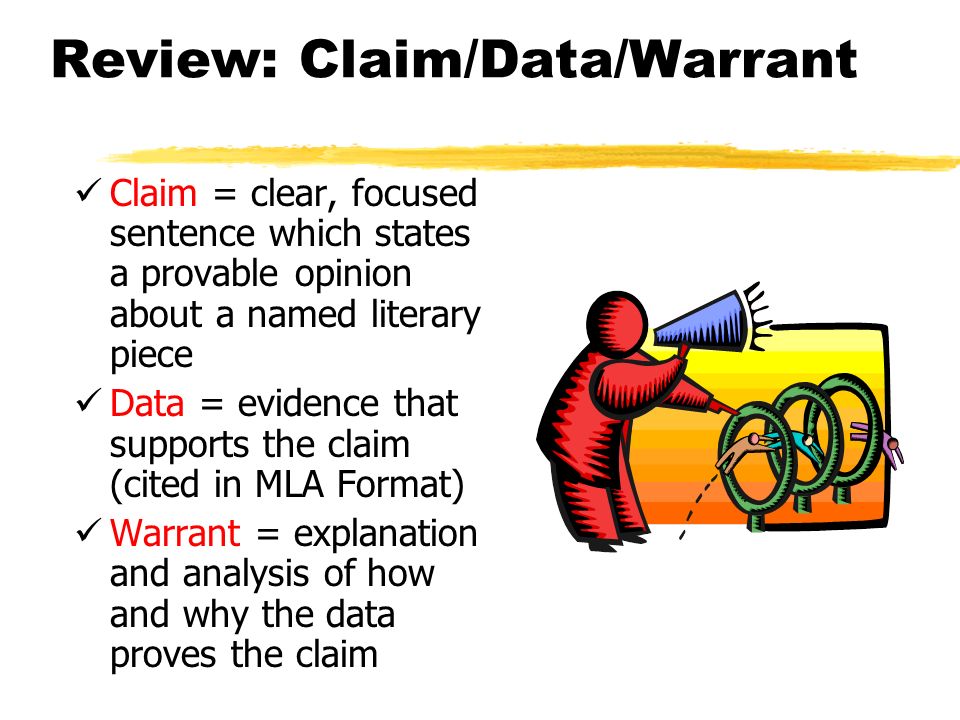Data Warrant Claim - In toulmin’s method, every argument begins with three fundamental parts: The claim, the grounds, and the warrant. A warrant links data and other grounds to a claim, legitimizing the claim by showing the grounds to be relevant. Claim/evidence/warrant (cl/ev/wa) helps you articulate logical—and so persuasive—arguments. Toulmin identifies the three essential parts of any argument as the claim; A claim is the assertion that. The warrant interprets the data and shows how it supports your claim. The warrant, in other words, explains why the data. This system has three basic elements (and. The data (also called grounds or evidence ), which support the claim;.
Claim/evidence/warrant (cl/ev/wa) helps you articulate logical—and so persuasive—arguments. A warrant links data and other grounds to a claim, legitimizing the claim by showing the grounds to be relevant. The warrant, in other words, explains why the data. The data (also called grounds or evidence ), which support the claim;. The warrant may be explicit or. The claim, the grounds, and the warrant. The warrant interprets the data and shows how it supports your claim. In toulmin’s method, every argument begins with three fundamental parts: Toulmin identifies the three essential parts of any argument as the claim; This system has three basic elements (and.
A warrant links data and other grounds to a claim, legitimizing the claim by showing the grounds to be relevant. A claim is the assertion that. The warrant may be explicit or. In toulmin’s method, every argument begins with three fundamental parts: The warrant, in other words, explains why the data. Claim/evidence/warrant (cl/ev/wa) helps you articulate logical—and so persuasive—arguments. The data (also called grounds or evidence ), which support the claim;. The warrant interprets the data and shows how it supports your claim. Toulmin identifies the three essential parts of any argument as the claim; This system has three basic elements (and.
PPT Claim Data Warrant PowerPoint Presentation, free download ID
Claim/evidence/warrant (cl/ev/wa) helps you articulate logical—and so persuasive—arguments. In toulmin’s method, every argument begins with three fundamental parts: This system has three basic elements (and. A warrant links data and other grounds to a claim, legitimizing the claim by showing the grounds to be relevant. The warrant, in other words, explains why the data.
Claim Data Warrant Examples
Claim/evidence/warrant (cl/ev/wa) helps you articulate logical—and so persuasive—arguments. In toulmin’s method, every argument begins with three fundamental parts: The claim, the grounds, and the warrant. Toulmin identifies the three essential parts of any argument as the claim; A warrant links data and other grounds to a claim, legitimizing the claim by showing the grounds to be relevant.
PPT What exactly is “ Claim / Data / Warrant ” ? PowerPoint
The claim, the grounds, and the warrant. The warrant interprets the data and shows how it supports your claim. In toulmin’s method, every argument begins with three fundamental parts: The warrant, in other words, explains why the data. Toulmin identifies the three essential parts of any argument as the claim;
PPT Claim Data Warrant PowerPoint Presentation, free download ID
In toulmin’s method, every argument begins with three fundamental parts: The warrant may be explicit or. The warrant interprets the data and shows how it supports your claim. This system has three basic elements (and. The claim, the grounds, and the warrant.
What exactly is “Claim / Data / Warrant” ? ppt video online download
The claim, the grounds, and the warrant. This system has three basic elements (and. Claim/evidence/warrant (cl/ev/wa) helps you articulate logical—and so persuasive—arguments. The warrant interprets the data and shows how it supports your claim. The data (also called grounds or evidence ), which support the claim;.
PPT ClaimDataWarrant PowerPoint Presentation, free download ID
The warrant may be explicit or. A claim is the assertion that. The data (also called grounds or evidence ), which support the claim;. This system has three basic elements (and. Claim/evidence/warrant (cl/ev/wa) helps you articulate logical—and so persuasive—arguments.
Claim Data Warrant Evidence Argument
The data (also called grounds or evidence ), which support the claim;. The claim, the grounds, and the warrant. This system has three basic elements (and. A claim is the assertion that. Toulmin identifies the three essential parts of any argument as the claim;
PPT CLAIM DATA WARRANT PowerPoint Presentation, free download
The data (also called grounds or evidence ), which support the claim;. A claim is the assertion that. Toulmin identifies the three essential parts of any argument as the claim; The warrant may be explicit or. In toulmin’s method, every argument begins with three fundamental parts:
PPT CLAIM DATA WARRANT PowerPoint Presentation, free download
The data (also called grounds or evidence ), which support the claim;. The warrant interprets the data and shows how it supports your claim. The warrant, in other words, explains why the data. The claim, the grounds, and the warrant. Claim/evidence/warrant (cl/ev/wa) helps you articulate logical—and so persuasive—arguments.
PPT Claim, Data, Warrant Next Exit PowerPoint Presentation, free
Claim/evidence/warrant (cl/ev/wa) helps you articulate logical—and so persuasive—arguments. Toulmin identifies the three essential parts of any argument as the claim; The warrant interprets the data and shows how it supports your claim. The warrant may be explicit or. The data (also called grounds or evidence ), which support the claim;.
The Data (Also Called Grounds Or Evidence ), Which Support The Claim;.
The warrant may be explicit or. A claim is the assertion that. The claim, the grounds, and the warrant. The warrant interprets the data and shows how it supports your claim.
This System Has Three Basic Elements (And.
The warrant, in other words, explains why the data. A warrant links data and other grounds to a claim, legitimizing the claim by showing the grounds to be relevant. Toulmin identifies the three essential parts of any argument as the claim; Claim/evidence/warrant (cl/ev/wa) helps you articulate logical—and so persuasive—arguments.









